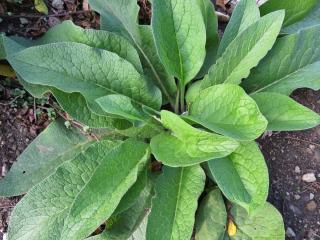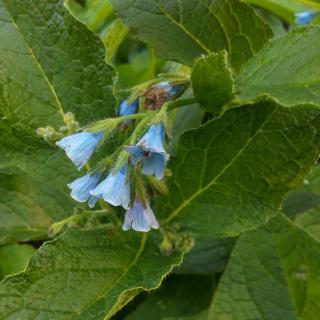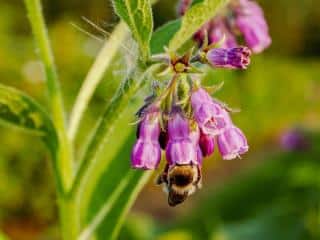

Comfrey is a versatile plant that has many uses in the garden.
Comfrey key facts:
Latin Name: Symphitum sp.
Common Name: Comfrey
Family: Boraginaceae
Type: perennial
Height: 1 to 4 feet (30 cm to 1.20 m), depending on species
Planting Density: 6 to 8 plants for 10 square feet (1 m²)
Exposure: preferably semi-shaded
Soil: any – Flowering: late spring, early summer – Foliage: evergreen
Comfrey is a perennial plant often seen as a wild and generous gift of nature. It’s a boon for gardeners, providing remedies for their garden, and a feast for pollinators with its honey-bearing flowers. Let’s delve into everything there is to know about comfrey and its multitude of benefits.
Comfrey, as a low-maintenance perennial, is a breeze to plant. No soil prep is needed, and you can plant it either in fall or spring.

Smart Tip: After planting your comfrey, apply natural mulch on the soil. It will retain soil moisture, something this perennial truly appreciates.

After roots have dug deep, all you need to do is renew foliage by cutting back the clump after flowering.
→ Tip: spread these nutrient-packed leaves under ornamentals and vegetables as a nutritious mulch.
If summer’s too dry, wait for rains to do your trimming. If your comfrey starts to spread too much, don’t hesitate to control it with a sharp spade to remove extending stems.
Often, the simplest way to multiply a comfrey plant is to divide it. Dig up all or part of the plant in fall, split the clump. Replant the new plants following our planting advice.
Comfrey is a sturdy perennial untouched by diseases. Pests don’t seem to have an impact either, except perhaps flea beetle that bores holes in leaves, especially during dry springs (they hate moisture).
Strength of comfrey lies in its numerous qualities, whether in garden or kitchen. When you use leaves, it’s better to harvest them at dawn if you use them fresh, or mid-afternoon if you plan on drying them.

But don’t forget the flowers! Some species like tuberous comfrey (Symphytum tuberosum) are particularly floriferous and recommended for attracting pollinators.
You can prepare foliage like spinach, either raw or cooked. However, keep consumption limited as it contains alkaloids that can be toxic to liver with too regular ingestion.
Comfrey is a perfect plant to adorn a flower bed, a slope, or to ornament base of a deciduous shrub. Even though you can pair it with any perennial in your garden, prefer to set it up with plants that don’t mind competition like lungworts, perennial geraniums or ferns.